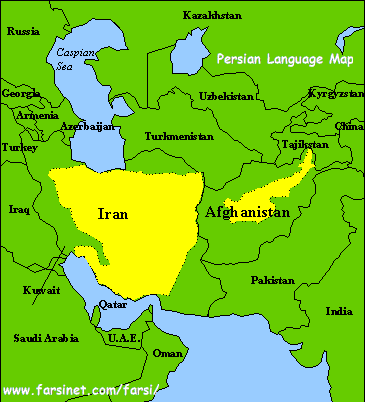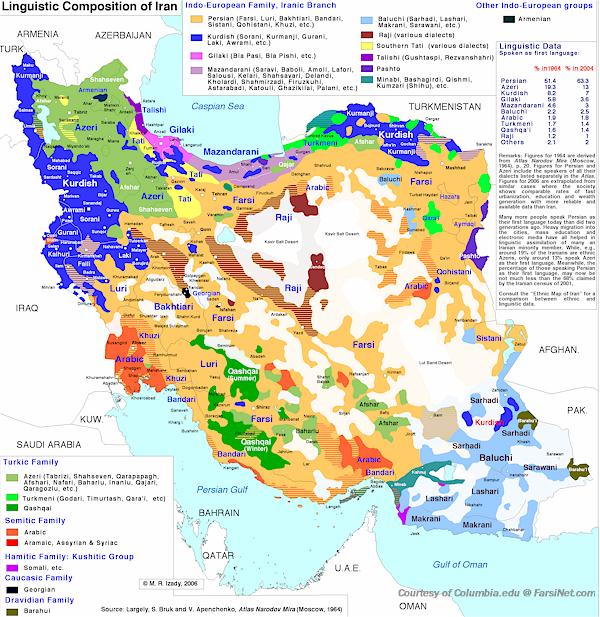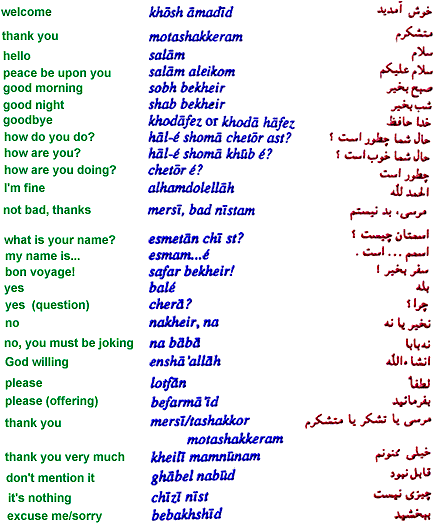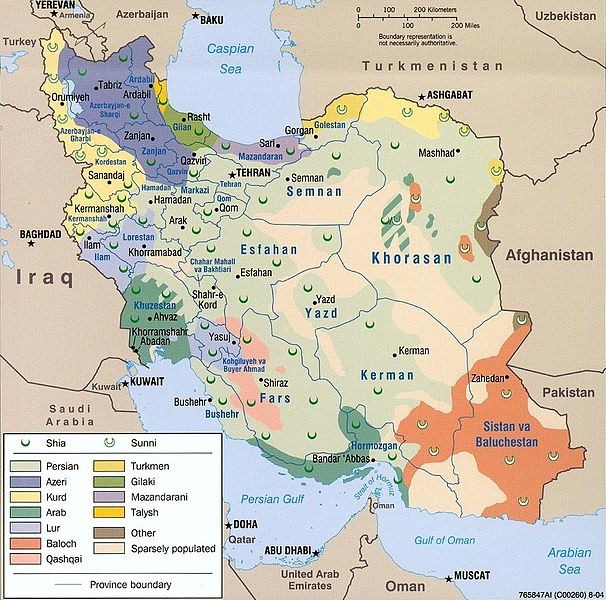Farsi - Persian Language
 Persian Language, also known as Farsi, is the most widely spoken
member of the Iranian branch of the Indo-Iranian languages, a
subfamily of the Indo-European languages. It is the language of
Iran (formerly Persia) and is also widely spoken in Afghanistan
and, in an archaic form, in Tajikistan and the Pamir Mountain
region.
Persian Language, also known as Farsi, is the most widely spoken
member of the Iranian branch of the Indo-Iranian languages, a
subfamily of the Indo-European languages. It is the language of
Iran (formerly Persia) and is also widely spoken in Afghanistan
and, in an archaic form, in Tajikistan and the Pamir Mountain
region.
Persian is spoken today primarily in Iran and Afghanistan, but was historically a more widely understood language in an area ranging from
the Middle East to India. Significant populations of speakers in other Persian Gulf countries (Bahrain, Iraq, Oman, People's
Democratic Republic of Yemen, and the United Arab Emirates), as well as large communities in the USA.
Total numbers of speakers is high: over 40 million Farsi speakers (about 60% of Iran's population); over 14 million Dari Persian
speakers in Afghanistan (50% of the population according to CIA World FactBook & Britannica); and about 2 million Dari Persian speakers in Pakistan.
|
In Afghanistan Farsi is spoken almost everywhere and over 50% of Afghanistan's total population speak Farsi or Dari.
The map on the right should cover Herat and the nothern parts of Afghanistan where the majority of people speak Farsi.
- Thank you, Laila Ahmadi |
Three phases may be distinguished in the development of Iranian
languages: Old, Middle, and Modern. Old Iranian is represented by
Avestan and Old Persian. Avestan, probably spoken in the northeast
of ancient Persia, is the language of the Avesta, the sacred
scriptures of Zoroastrianism. Except for this scriptural use,
Avestan died out centuries before the advent of Islam. Old
Persian is recorded in the southwest in cuneiform inscriptions
of the Persian kings of the Achaemenid dynasty (circa 550-330 BC),
notably Darius I and Xerxes I. Old Persian and Avestan have close
affinity with Sanskrit, and, like Sanskrit, Greek, and Latin, are
highly inflected languages.
When "Persia" became "Iran"
This article is a part of "Persia or Iran" by Professor Ehsan Yarshater, published in Iranian Studies, Vol. XXII, No.1, 1989.
In 1935 the Iranian government requested those countries which it had diplomatic relations with, to call Persia "Iran," which is the name of the country in Persian.
The suggestion for the change is said to have come from the Iranian ambassador to Germany, who came under the influence of the Nazis. At the time Germany was in the grip of racial fever and cultivated good relations with nations of "Aryan" blood. It is said that some German friends of the ambassador persuaded him that, as with the advent of Reza Shah, Persia had turned a new leaf in its history and had freed itself from the pernicious influences of Britain and Russia, whose interventions in Persian affairs had practically crippled the country under the Qajars, it was only fitting that the country be called by its own name, "Iran." This would not only signal a new beginning and bring home to the world the new era in Iranian history, but would also signify the Aryan race of its population, as "Iran" is a cognate of "Aryan" and derived from it.
The Iranian Ministry of Foreign Affairs sent out a circular to all foreign embassies in Tehran, requesting that the country thenceforth be called "Iran." Diplomatic courtesy obliged, and by and by the name "Iran" began to appear in official correspondence and news items.
At first "Iran" sounded alien (for non-Iranians), and many failed to recognize its connection with Persia. Some (Westerners) thought that it was perhaps one of the new countries like Iraq and Jordan carved out of the ruins of the Ottoman Empire, or a country in Africa or Southeast Asia that had just been granted independence; and not a few confused it with Iraq, itself a recent entity.
As time passed and as a number of events, like the Allied invasion of Iran in 1941 and the nationalization of the oil industry under Prime Minster Dr Mohammad Mosaddeq, put the country in the headlines, the name "Iran" became generally accepted, and "Persia" fell into comparative disuse, though more slowly in Britain than in the United States.
|
|
|
Click on the Iran Linguistic Composition map for a larger image |

|
|---|
|
Learn a few Persian (Farsi) Words and Common Phrases
|
|---|

|
|
|---|
|


ازدواج مسیحی

اسم او عجيب خواهد بود
اشتياق براي كامل
شدن
- حكمت از رساله يعقوب
 . .
کتابخانه و انتشارات ايمان و اميد
. . . آیا
اطمینان کامل دارید

ايرانيان در کتاب مقدس



تجهيز مقدسان
- موسسه تعليم
تشخيص اراده خدا
تشخيص دعوت الهى براي خدمت
تثلیث
تثلیث
به زبان ساده


حقیقت: فالگیری، جادوگری، احضار روح
حل مسائل زناشويي
خانواده مسیحی

خداوند
محبّت
است
چگونه بر شرارت غلبه كنيم
چرا
زلزله؟



 راديو
ندای
اميد
راديو
ندای
اميد

رقابت در
خانه خدا
زندگي در خانواده مسيحي
دفاعیه کشیش مهدی دیباج






صلح و آرامش با خدا
شعر فارسی و شاعران ايران









کتاب مقدّس
و مثل های پارسی
کتاب
مقدس به زبان فارسی

|

Iran: Country Information:
- Name was changed from Persia to Iran in 1934.
- Iran became an Islamic Republic in 1979.
- Iran-Iraq war lasted fro over eight years from 1980-1988
- Capital: Tehran
- Population: 76.9 million (2010 estimate) - Ranks 18th in the World
- 0-14 years: 21.7% (male 7,394,841/female 7,022,076)
- 15-64 years: 72.9% (male 24,501,544/female 23,914,172)
- 65 years and over: 5.4% (male 1,725,828/female 1,870,823) (2010 est.)
- Capital: Tehran
- Major language: Persian
- Major Religion: Islam
- Life expectancy: 69 years (men), 72 years (women)
- Monetary unit: 10 Iranian rials = 1 Toman
- Main exports: Petroleum, carpets, agricultural products and spices such as Saffron
- Average annual income: US$1,680 (World Bank, 2001)
- GDP - Per capita: $11,200 (2010 est.) - World Rank = 99
- Ethnic Groups: Persian 51%, Azeri 24%, Gilaki & Mazandarani 8%
Kurd 7%, Arab 3%, Lur 2%, Baluch 2%, Turkmen 2%, Other 1%
- Religion: Muslim 98% (Shia 89%, Sunni 9%), other (includes Zoroastrian, Jewish, Christian, and Baha'i) 2%
- For more information and upto date vital statistics on Iran visit Statistical Center of Iran (
 ) )

Farsi (Persian)
Farsi is a member of the Iranian branch of the Indo-Iranian language family; it is the official language of Iran. It is most closely related to Middle and Old Persian, former languages of the region of Fars ("Persia") in southwestern Iran. Modern Persian is thus called Farsi by native speakers. Written in Arabic characters, modern Persian also has many Arabic loanwords and an extensive literature.
Persian Poetry
Persian Christian Hymnals
Persian Christian Wedding Hymn
Persian Children Stories
Country Profile: Iran
- From BBC News
|
Could not open : No such file or directory
Could not open : No such file or directory
Could not open : No such file or directory
Could not open : No such file or directory
Could not open : No such file or directory
|
Middle Iranian is represented not only by Middle Persian and the
closely related Parthian language but also by several Central
Asian tongues. Parthian was the language of the Arsacid or
Parthian Empire (circa 250 BC-AD 226). Although it is known
chiefly through inscriptions of the early kings of the following
Sassanian period, Parthian declined when Sassanian power expanded.
During the Arsacid period, however, it influenced Persian. The
language of the Sassanian Empire (AD 226-641) was Middle Persian,
often called Pahlavi (a term more strictly reserved for a form of
the language used in certain Zoroastrian writings). Middle
Persian has a simpler grammar than Old Persian and was usually
written in an ambiguous script with multivalent letters, adopted
from Aramaic; it declined after the Arab conquest in the 7th
century. Although much of the Middle Persian literature was
translated into Arabic, the bulk of its writings was lost during
Islamic times. Other Middle Iranian tongues were also spoken in
Sassanian Persia or in bordering regions of Central Asia:
Khwarazmian, in Khiva; Bactrian, in Bactria; Sogdian, in the vast
region of Sogdiana, including the cities of Samarqand and Bukhoro;
and Saka (a name associated with various Scythian kingdoms), in
Chinese Turkestan. Sogdian produced a body of Christian, Buddhist,
and secular literature, and Saka's Khotanese dialect was the
vehicle of an important Buddhist literature. Most Khwarezmian
texts are from the post-Islamic period. Bactrian is known only
in a few recently discovered inscriptions in Afghanistan.
Modern Persian had developed by the 9th century. It is a
continuation of an area-wide standard language that had
considerable Parthian and Middle Persian elements, with
additional influences from other Iranian languages. Written
in Perso-Arabic script (an expanded version of Arabic script),
it has been the official and cultural language of Persia since
it first appeared. Its grammar is simpler than that of Middle
Persian, and it has absorbed a vast Arabic vocabulary.
|


 Persian Language, also known as Farsi, is the most widely spoken
member of the Iranian branch of the Indo-Iranian languages, a
subfamily of the Indo-European languages. It is the language of
Iran (formerly Persia) and is also widely spoken in Afghanistan
and, in an archaic form, in Tajikistan and the Pamir Mountain
region.
Persian Language, also known as Farsi, is the most widely spoken
member of the Iranian branch of the Indo-Iranian languages, a
subfamily of the Indo-European languages. It is the language of
Iran (formerly Persia) and is also widely spoken in Afghanistan
and, in an archaic form, in Tajikistan and the Pamir Mountain
region.

 Persian/Farsi Language Related Links
Persian/Farsi Language Related Links